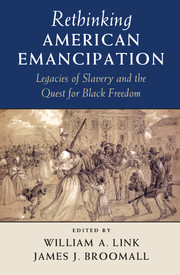Book contents
- Frontmatter
- Contents
- List of figures
- Notes on the Editors and Contributors
- Acknowledgments
- Introduction
- I CLAIMING EMANCIPATION
- II CONTESTING EMANCIPATION
- 4 “One Pillar of the Social Fabric May Still Stand Firm”: Border South Marriages in the Emancipation Era
- 5 Axes of Empire: Race, Region, and the “Greater Reconstruction” of Federal Authority after Emancipation
- 6 Fear of Reenslavement: Black Political Mobilization in Response to the Waning of Reconstruction
- III REMEMBERING EMANCIPATION
- Index
5 - Axes of Empire: Race, Region, and the “Greater Reconstruction” of Federal Authority after Emancipation
from II - CONTESTING EMANCIPATION
Published online by Cambridge University Press: 05 November 2015
- Frontmatter
- Contents
- List of figures
- Notes on the Editors and Contributors
- Acknowledgments
- Introduction
- I CLAIMING EMANCIPATION
- II CONTESTING EMANCIPATION
- 4 “One Pillar of the Social Fabric May Still Stand Firm”: Border South Marriages in the Emancipation Era
- 5 Axes of Empire: Race, Region, and the “Greater Reconstruction” of Federal Authority after Emancipation
- 6 Fear of Reenslavement: Black Political Mobilization in Response to the Waning of Reconstruction
- III REMEMBERING EMANCIPATION
- Index
Summary
As the most sacred holiday in their calendar, Easter offers Christians an opportunity to reflect upon the joyous ideas of salvation and rebirth. The events of Easter 1873, however, awakened fears of dissolution and death. As Americans read their newspapers in the following week, reports of two violent events thousands of miles apart troubled their reflections. In rural Colfax, Louisiana, white paramilitaries, members of the nascent White League movement, killed more than 100 freedpeople in an effort to unseat local Republican officeholders. The Colfax Massacre was part of a larger statewide effort by the Democratic Party to regain control of the state's political system and end Republican efforts to extend civil and political rights to the state's former slaves. That same weekend on the California-Oregon border, a small group of Modoc Indians killed Major General Edward Canby, the U.S. commander of the Pacific Northwest, and another member of his “peace council,” who were attempting to entice the Modocs back onto the Klamath Reservation. The Modocs had refused previous entreaties, disrupting the process of settlement in the area with frequent skirmishes with white civilians and government officials and igniting the “Modoc War,” which lasted for most of the winter and spring of 1872–1873. On the surface, these two events may seem unrelated, but in the minds of many observers at the time, they represented a disconcerting problem in the national effort to destroy slavery and reconstruct Southern society: the nation's burgeoning culture of imperialism in the West.
This essay explores the complicated reactions to the Modoc War and the Colfax Massacre, using them as a way to gauge popular understandings of the implications of emancipation and Southern Reconstruction for the nation's advancing imperial endeavors. To many nineteenth-century Americans, the Civil War and Reconstruction were part of a longer, and in some minds, darker history of territorial expansion and conquest. As critic Amy Kaplan points out, “representations of U.S. imperialism were mapped not through a West/East axis of frontier symbols and politics, but instead through a North/South axis around the issues of slavery, Reconstruction and Jim Crow segregation.” In other words, western expansion and conquest of native peoples cannot be understood simply as imperatives of some frontier mentality, but rather as outgrowths of the battle over slavery, its demise, and the reconstruction of American race relations.
- Type
- Chapter
- Information
- Rethinking American EmancipationLegacies of Slavery and the Quest for Black Freedom, pp. 119 - 145Publisher: Cambridge University PressPrint publication year: 2015

